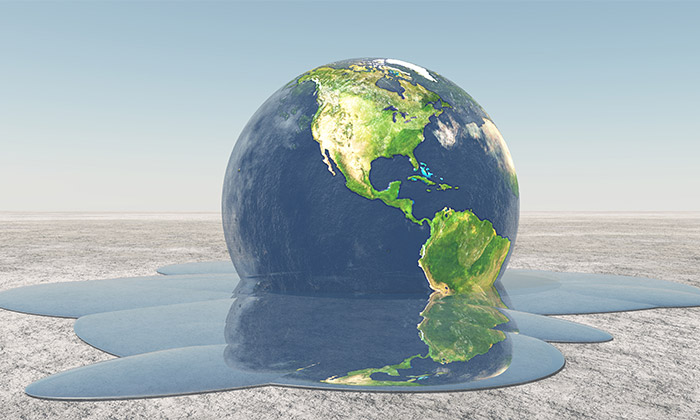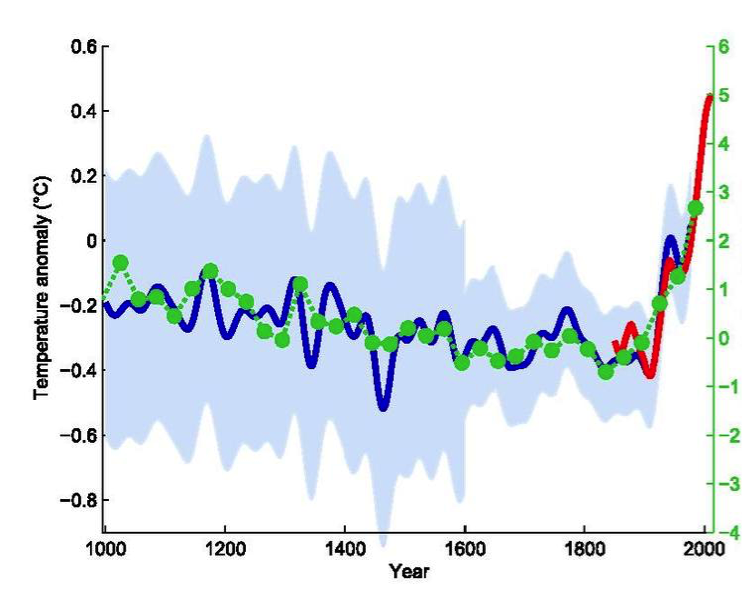
Bentley Leads Research, Conversations on Climate Change
The Hockey Stick
What do a hockey stick and a dipstick have in common?
(This isn’t a joke about sports or an old “Car Talk” routine.)
Both of them are playing a role in climate change research and conversations at Bentley University this fall.
The hockey stick image first surfaced in climate science discussions in the late 1990s. Graphs resembling a hockey stick on its side began to appear in the work of Michael E. Mann—who will be Bentley University’s Jeanne and Dan Valente Center for the Arts and Sciences’ Distinguished Visiting Scholar this fall—and his research colleagues in a paper first published in 1998.
The graphs represent the global mean temperature over time stretching back in various studies to as long ago as the year 1000. The graphs showed a slowly declining mean temperature range—looking like the long shaft of a hockey stick—until about 1900, when a sharp increase in mean temperatures from then to the present day—the blade of the stick—appears. Here’s a reproduction of the original hockey stick graph:

The term “hockey stick” was first coined to describe this pattern by climatologist Jerry D. Mahlman in 1999, and has been featured prominently in scientific reports including those published by the U.N. International Panel on Climate Change. The term was also featured in former Vice President Al Gore’s film on climate change, An Inconvenient Truth, and its sequel.
Despite challenges to its underlying data and methodology by climate change skeptics, the hockey stick graph first published by Mann and his colleagues has been successfully, independently reconstructed by peer-reviewed researchers dozens of times. The long gradual decline in global temperature represents part of a natural climate cycle that has been extended back 12,000 years, and would have led us slowly into the next Ice Age had not humans intervened by loading the atmosphere with carbon (greenhouse gases) by burning fossil fuels. The hockey stick remains the leading visual representation of the rapid acceleration of global mean temperatures in the 20th century and a stark reminder of the challenges facing the planet as a result.
Bringing the “Climate Wars” Conversation to Bentley
Mann will bring his expertise on climate, the hockey stick and “the climate wars” to Bentley this November via a public lecture (see details below), guest teaching and a faculty seminar.
Mann is currently Professor of Meteorology and Director of the Earth System Science Center at Pennsylvania State University. A climatologist and geophysicist, he’s the author of more than 200 peer-reviewed and edited publications on climate science, and the author of books such as The Madhouse Effect: How Climate Change Denial is Threatening Our Planet, Destroying our Politics, and Driving Us Crazy (2016), and The Hockey Stick and the Climate Wars: Dispatches from the Front Lines (2012).
Mann has been a “lightning rod” in the debates about climate change thanks in part to the popularity of the hockey stick image and his fierce advocacy for the role of science in shaping public policy. Despite an overwhelming scientific consensus about the reality of climate change, Mann argues, our politics and our media culture—which often depends upon a false “equal time for both points of view” paradigm to create conflict—have distorted our understanding of basic science and politicized data to our peril. Mann’s been the subject of death threats and has also had his research data investigated and subpoenaed—despite its already having been publicly available—by both the Virginia Attorney General and United States Office of Inspector General.
Fusion of the Arts and Sciences at a Business University
Valente Center Director Dave Szymanski (Associate Professor, Natural and Applied Sciences) says Mann and his work are “a great representation of what we hope to achieve at the Center with the Visiting Scholar Program, demonstrating the powerful intersection of the arts and sciences with public policy and business.” Szymanski says businesses are deeply involved in the climate change discussion and policy-making efforts worldwide and “have often taken a leadership role where politicians have feared to tread.”
“As a business university,” Szymanski says, “we take very seriously our mission to keep arts and sciences at the center of our students’ education, and climate science is one of, if not the, central scientific and public policy and business issues of our time. We’re thrilled to have Dr. Mann here as part of that conversation and education.”
Mann will lead a faculty seminar and guest lecture in two courses during his visit to Bentley, one honors course focusing on the legal and public policy implications of scientific research, and another on the science of sustainability. The Visiting Scholars and Fellows Program at the Valente Center is funded in part by the National Endowment for the Humanities. You can learn more about it here.
The Dipstick
Mann’s connection to Bentley doesn’t end with his status as a Visiting Scholar, however. In fact, he’s served on the advisory board for the National Science Foundation, which funds the work of a Bentley professor, P. Thompson (Thom) Davis (Natural and Applied Sciences), who also studies climate change. (Davis will be Mann’s formal “Faculty Host” during his time at Bentley.)
And that’s where the dipstick comes in.
Whereas Mann’s research has measured the increase in global mean temperatures in the period from 1000 to the present, Davis and his colleagues look back even further to get a sense of how earlier periods of global warming may have unfolded. Specifically, Davis seeks to understand earlier periods of deglaciation—the rate at which glaciers melted and influenced sea level rise. More data about earlier periods of warming and deglaciation may hold the key to predicting and possibly mitigating the worst effects of future climate changes.
Davis has been researching the history of deglaciation in Canada, the Rocky Mountains, and New England for decades. Last year, he and two colleagues from Boston College and the University of Vermont were awarded a three-year, $265,117 grant from the National Science Foundation to study the timing and rate of the thinning of the southeastern Laurentide Ice Sheet during the last major period of deglaciation after the Pleistocene epoch, or the “Last Ice Age.”
The Laurentide Ice Sheet was the largest of the Last Ice Age ice masses, covering and shaping millions of square miles of present-day Canada and much of the northern United States, gouging out the Great Lakes and molding all of New England as the ice sheet advanced and retreated and ultimately thinned out and disappeared. The changes in the ice sheet over time influenced the jet stream, major ocean currents, and local climates throughout North America.
To measure the vertical thinning of the Laurentide Ice Sheet, the researchers are using an ingenious “dipstick” method, first developed by glacial geologists in Antarctica, which measures the exposure of glacial boulders and glacially eroded bedrock to cosmic rays. Cosmic ray exposure produces cosmogenic nuclides—a particular kind of atom—in the exposed rock that can be measured. Sampling rocks for nuclides at various elevations is like using a dipstick to measure the depth of liquid in a container, except in this case the “container” is the mountainside.
By identifying the presence of nuclides and the age of exposure at various elevations on mountains throughout the study area, Davis and colleagues are tracing the rate at which the Laurentide Ice Sheet thinned vertically. As their abstract says, the presence of the nuclides reveals “when the ice sheet surface lowered below various elevations, much like rings in a bathtub.” From summits to valleys, the exposure ages revealed by the nuclides will paint a picture of the vertical rate of thinning of the Laurentide Ice Sheet.
Influential Ice
The ice sheet’s most significant impact during its melting period may have been on sea levels. Understanding how the Laurentide Ice Sheet affected sea levels may be crucial to understanding the challenges of present-day global warming.
As Davis and his colleagues explain in their abstract, “The largest, but also most uncertain, control on the pace and magnitude of future sea level rise is how the Greenland and Antarctic Ice Sheets will respond to continued warming. The end of the Last Ice Age provides an outstanding opportunity to probe this question since it featured the collapse of major ice sheets and abrupt multi-meter jumps in sea level that remain to be fully explained.”
Davis is intrigued by the mysteries that he and his colleagues may be able to unravel, saying, “We know there was a period when sea levels rose very rapidly—we think that there should be a corresponding time when ice sheets around the globe thinned dramatically. The modern equivalent might be seen in anthropogenic changes to climate, so we might gather useful information on how fast modern sea level will rise in the future.”
Early Findings
Now in the second year of a three-year funded study period, Davis’s work is yielding some early results. Specifically, the dipstick model for measuring the rate of deglaciation seems to be holding up as a useful method, but not all the ages of exposure match what Davis and his colleagues had expected to find across the New England and Canadian ranges sampled. “We’re a little ‘too young’ at some of the elevations,” he says, “and in other locations we’re seeing evidence of exposures that are ‘too old’ and date back to prior periods of deglaciation on summits where erosion by the ice sheet was insufficient to remove pre-existing nuclides.” Davis and colleagues are adjusting their methodology and adding more summits to address these early findings.
“We did a ton of sampling in the summer of 2017,” he says, and “all the places targeted on our original map have been completed.” Davis and colleagues have worked in Acadia National Park, Pineo Ridge, and Katahdin in Maine, on Mt. Greylock in Massachusetts, on Mt. Jacques Cartier in the Gaspé Peninsula, in the Catskills, on Mount Mansfield in Vermont, and on Mt. Washington and other summits in New Hampshire. Papers of their results to date with these methods have been published in the Geology (2015) and in Quaternary Science Reviews (2015 and 2017).
Climate Connections
Davis has known Mann personally since Mann did a post-doc with a research colleague of Davis’s at UMass-Amherst in the late 1990s and, like Szymanski, is thrilled that Mann is coming to Bentley to talk about his research and the role of science in public policy.
“The attacks on Mike were unprecedented, and those that came from the political sphere were designed to scare and silence scientists,” says Davis. “Mike didn’t ask to become a target. He was just doing good, reproducible science and publishing it in peer-reviewed journals. But he’s turned out to be not-such-an-easy target and has become a real public advocate for science.”
Like Szymanski, Davis also notes the importance of familiarity with climate science in a business education: “Students at Bentley really respond to our work—they know these facts will be driving the decisions they’ll need to make as leaders of industry and civic society as we all grapple with the impacts of climate change.”
------
Mann’s public lecture will be on Thursday, November 16 at 5 pm in the Koumantzelis Auditorium, Lindsay Hall, at Bentley University, is free and open to the public, and is co-sponsored by the Valente Center, the Natural and Applied Sciences department, and Bentley’s Office of Sustainability.

